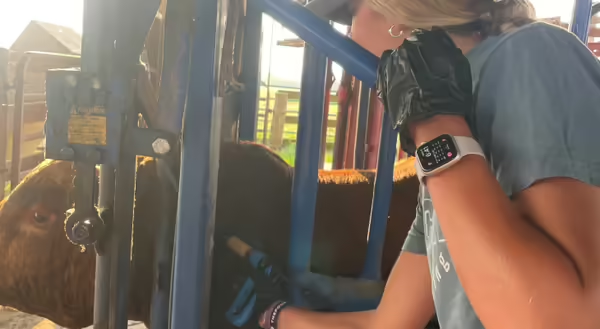
Summertime means the start of fly season, which in turn can lead to higher numbers of pinkeye cases. As face flies buzz from cow to cow, they land on the mucus membrane and tear duct of the eye which directly transmits bacteria. When using preventative measures like proper fly control, reducing eye irritants, and maintaining strong health and vaccination protocols, pinkeye can be a manageable issue within a herd.
How do cows get pinkeye?
There are different strains of pinkeye present in cattle populations, but we’re discussing ‘Summer Pinkeye’ (Moraxella bovis.) Pinkeye in cattle is an infection on the eye surface and the eyelid. Common causes of this pinkeye are physical trauma (i.e. Fighting, rubbing on gates), blowing dust, seeds from forage headings getting into the eye, and bacteria transmitted by face flies. Young calves are more susceptible than older cows due to their underdeveloped immune systems.
What are the signs of an infection?
Some of the first indicators that an animal has pinkeye are excessive tearing in the eye, tear stains, and sensitivity to sunlight. As the infection progresses, you may start to see a cloudy spot on the surface of the eye or ulcers developing. This could ultimately lead to an abscess on the cornea, blindness, or the loss of an eye.
How do you treat it?
If you observe the signs of a pinkeye infection, it is important to isolate the infected animal. Pinkeye is very contagious, and allowing infected animals to continue to run with the herd can lead to an outbreak. Two common antibiotics used to treat pinkeye are Tetracycline and Tulathromycin (Draxxin). It is important to remember that all antibiotic use will have slaughter withdrawal periods. Recovery from pinkeye doesn’t happen immediately. The eye will continue to show signs of infection until all the bacteria have been cleared. Eye patches also aid in treatment to keep the eye clear from other irritants and protect it from sunlight.
Vaccines
Vaccines are one way to prevent cases of pinkeye. There are many pinkeye vaccines on the market, and by consulting with your veterinarian or reading labels you can determine which option is best for your herd. Using autogenous vaccines can make the process uniquely fitted for your herd. These types of vaccines are tailored to the specific strains of pinkeye that your cattle may struggle with. It is recommended to give pinkeye vaccinations 3-6 weeks before the summer season. This gives the cattle time to develop immunity before the peak pinkeye season. With eye irritation being one of the main causes of pinkeye, even vaccinated cattle are not completely immune if conditions are favorable for pinkeye.
Other forms of prevention
With face flies being a main carrier of the pinkeye bacteria, it’s important to keep their populations low. Face flies are most active on warm and sunny days, so providing shade for cattle on pasture can provide some relief. Fly tags are another good way to reduce the number of face flies that are active on both cows and calves. Other notable methods of fly control include oilers, pour-on, fly spray, or feed through products. Maintaining a clean facility and eliminating fly breeding grounds like manure piles are good ways to decrease fly populations.
Summary
With pinkeye being one of the more common infections during the summer, it’s important to know how to effectively prevent and treat it. Ensuring cattle have a good body condition and are consuming adequate nutrition will help cattle to maintain stronger immune responses. Sick animals are less inclined to eat, which results in less productive cattle. Cattle with residual scarring or blindness from pinkeye have a reduced sale value, and infected animals are not accepted at most sale yards. Having a prevention plan, controlling the fly population, and vaccinating cattle are all measures that can be taken to prevent cases of pinkeye.
About the Author
Mabry Bruhn is a student at the University of Illinois Urbana-Champaign who works in beef production, research, and producer outreach as a University of Illinois Extension intern in the I-BELIEF program through the Department of Animal Sciences in the College of Agricultural, Consumer and Environmental Sciences. This article has been reviewed by Extension Commercial Agriculture Educator, Travis Meteer.